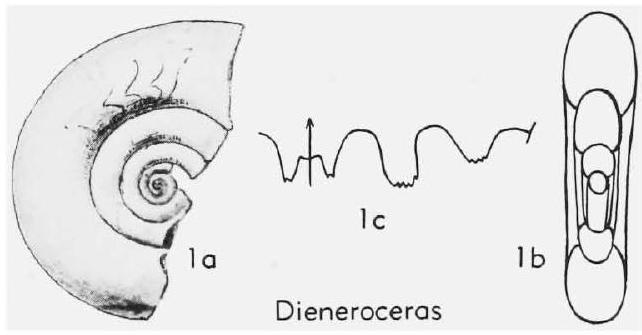Welcome to the Treatise on Invertebrate Paleontology!
Please enter a genera name to retrieve more information.

Dieneroceras
Classification
Phylum:
Mollusca
Class:
Cephalopoda
Subclass:
Ammonoidea
Order:
Ceratitida
Suborder:
Ceratitina
Superfamily:
Otocerataceae
Family:
Dieneroceratidae
Formal Genus Name and Reference:
Dieneroceras SPATH, 1934
Type Species:
Ophiceras dieneri Hyatt & SMITH, 1905
Images
(Click to enlarge in a new window)
Fig. 166,1. *D. dieneri (Hyatt-S.), *, *.
Synonyms
Geographic Distribution
Scyth., Calif.-Nev.-Ida.
Age Range
Beginning Stage in Treatise Usage:
Scyth.
Beginning International Stage:
Induan
Fraction Up In Beginning Stage:
0
Beginning Date:
251.9
Ending Stage in Treatise Usage:
Scyth.
Ending International Stage:
Olenekian
Fraction Up In Ending Stage:
100
Ending Date:
246.7
Description
Evolute, slightly compressed, whorl sec- tion rounded, venter arched. Suture ceratitic or goniatitic, generally with only 2 lateral lobes. Considered to be persisting stock from ophiceratids and probably root of some later ornamented stocks.
References
Spath, L. F., 1934, The Jurassic and Cretaceous ammonites and belemnites of the Attock district: Palaeont. Indica, new ser., v. 20, mem. 4, p. 1-39, pl. 1-6.
Museum or Author Information
Classification
Phylum:
Mollusca
Class:
Cephalopoda
Subclass:
Ammonoidea
Order:
Ceratitida
Suborder:
Ceratitina
Superfamily:
Otocerataceae
Family:
Dieneroceratidae
Formal Genus Name and Reference:
Dieneroceras SPATH, 1934
Type Species:
Ophiceras dieneri Hyatt & SMITH, 1905
Images
(Click to enlarge in a new window)
Fig. 166,1. *D. dieneri (Hyatt-S.), *, *.
Synonyms
Geographic Distribution
Scyth., Calif.-Nev.-Ida.
Age Range
Beginning Stage in Treatise Usage:
Scyth.
Beginning International Stage:
Induan
Fraction Up In Beginning Stage:
0
Beginning Date:
251.9
Ending Stage in Treatise Usage:
Scyth.
Ending International Stage:
Olenekian
Fraction Up In Ending Stage:
100
Ending Date:
246.7
Description
Evolute, slightly compressed, whorl sec- tion rounded, venter arched. Suture ceratitic or goniatitic, generally with only 2 lateral lobes. Considered to be persisting stock from ophiceratids and probably root of some later ornamented stocks.
References
Spath, L. F., 1934, The Jurassic and Cretaceous ammonites and belemnites of the Attock district: Palaeont. Indica, new ser., v. 20, mem. 4, p. 1-39, pl. 1-6.
